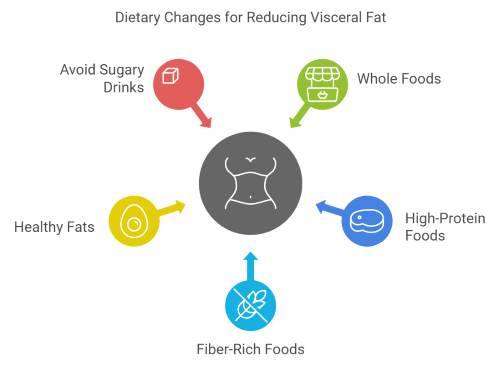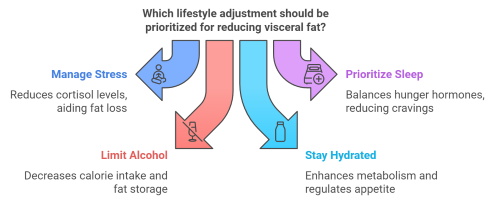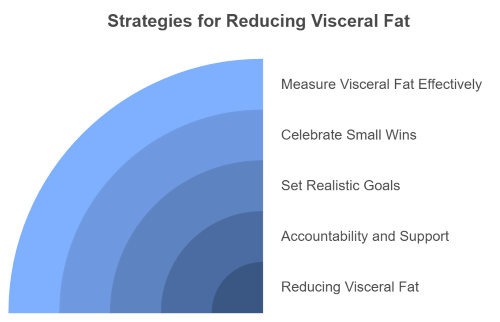1. Understanding Visceral Fat
Visceral fat is a type of body fat stored within the abdominal cavity, surrounding important internal organs like the liver, stomach, and intestines. Unlike the fat you can pinch under your skin (subcutaneous fat), visceral fat is located deeper within the body. It plays a role in insulating and protecting your organs, but excess visceral fat can be harmful to your health.
1.1 What is Visceral Fat?
Visceral fat is a metabolically active fat that can produce hormones and inflammatory substances, which may impact your overall health. In small amounts, it’s natural and necessary for bodily functions. However, high levels of visceral fat are linked to various health risks.
1.2 Why is Visceral Fat Dangerous?
Excess visceral fat is associated with serious health conditions, including heart disease, type 2 diabetes, and certain cancers. It increases inflammation in the body and disrupts normal hormonal balance, which can lead to metabolic disorders. Unlike fat stored in other areas, visceral fat poses a greater threat because of its proximity to vital organs, potentially interfering with their functions.
1.3 Key Differences Between Visceral and Subcutaneous Fat
While subcutaneous fat lies just beneath the skin and is easier to see, visceral fat is hidden and may not always be apparent in individuals with a healthy body weight. Subcutaneous fat acts as an energy reserve and provides insulation, whereas excess visceral fat contributes to health risks without offering the same benefits.
Understanding visceral fat and its effects on your body is crucial. By recognizing the dangers of excess visceral fat, you can take proactive steps to manage it effectively and improve your overall health.
Affiliate Disclaimer
This blog post may include links to affiliate sites. If you click on an affiliate link and make a purchase, we may earn a small commission or receive other compensation at no extra cost to you. Please note that many of the links on our site are affiliate links. Our use of these links does not impact the products, services, or websites we recommend to you. This disclaimer covers all forms of communication with you, including our website, email, phone, social media, products, and other platforms.
Amazon Affiliate Disclaimer
We participate in the Amazon Services LLC Associates Program, an affiliate marketing program that allows us to earn fees by linking to Amazon.com and its affiliated sites. If you click on an Amazon affiliate link on our site and make a purchase, we may receive a small commission at no additional cost to you.
2. Diet Changes to Reduce Visceral Fat
Making specific dietary adjustments is one of the most effective ways to reduce visceral fat. Certain foods and eating habits can promote fat burning, while others may contribute to fat accumulation. By focusing on a balanced, nutrient-rich diet, you can work toward decreasing visceral fat and improving your overall health.

2.1 Adopt a Balanced Diet with Whole Foods
A diet based on whole, unprocessed foods is a key factor in reducing visceral fat. Prioritize fresh vegetables, fruits, lean proteins, and whole grains. These foods are rich in essential nutrients and fiber, helping you feel full longer and reducing your calorie intake naturally. Whole foods also stabilize blood sugar levels, minimizing the risk of fat storage in the abdominal area.
2.2 Focus on High-Protein and Fiber-Rich Foods
Protein is essential for muscle repair and growth, and it plays a significant role in reducing visceral fat. Lean sources like chicken, fish, tofu, and beans can boost your metabolism and promote fat loss. At the same time, fiber-rich foods like oats, lentils, and vegetables improve digestion and reduce appetite by slowing the absorption of sugar into the bloodstream. A diet high in protein and fiber is particularly effective for targeting visceral fat.

2.3 Avoid Sugary Drinks and Processed Foods
Sugary beverages and processed snacks are major contributors to visceral fat. These foods are high in empty calories and spike blood sugar levels, leading to increased fat storage, particularly around the abdomen. Replace sugary drinks with water, herbal teas, or black coffee, and opt for whole-food snacks like nuts, fruit, or yogurt to satisfy cravings without encouraging fat accumulation.
2.4 Incorporate Healthy Fats for Better Metabolism
Not all fats are created equal. Healthy fats, such as those found in avocados, nuts, seeds, and olive oil, can help reduce visceral fat by supporting metabolic processes. These fats provide sustained energy and improve the body’s ability to burn calories. Avoid trans fats and highly processed oils, which are linked to an increase in visceral fat.

Adjusting your diet to include these healthy habits can significantly impact visceral fat reduction. By focusing on whole, nutrient-dense foods, avoiding harmful additives, and balancing your macronutrients, you’ll set a strong foundation for lasting changes.
3. Exercise Routines to Target Visceral Fat
Physical activity is a powerful tool for reducing visceral fat. Incorporating effective exercises into your routine can help burn calories, improve metabolic health, and specifically target fat stored deep within the abdominal cavity. By combining aerobic activities with strength training, you can optimize your fat-burning efforts and improve overall fitness.
3.1 High-Intensity Interval Training (HIIT) Benefits
High-Intensity Interval Training (HIIT) is one of the most effective exercise methods for burning visceral fat. HIIT involves short bursts of intense exercise followed by brief recovery periods. This approach increases your heart rate, burns more calories in less time, and boosts your metabolism long after your workout ends. Exercises like sprinting, cycling, or jumping rope in interval formats are excellent for targeting visceral fat.
3.2 Strength Training to Build Lean Muscle
Strength training plays a crucial role in reducing visceral fat by increasing muscle mass. Muscle tissue burns more calories at rest compared to fat tissue, which means a higher resting metabolic rate. Incorporate resistance exercises such as weightlifting, bodyweight movements, or resistance band workouts. Focus on compound exercises like squats, deadlifts, and push-ups, which engage multiple muscle groups and maximize calorie burn.

3.3 Add Daily Aerobic Exercise for Consistency
Aerobic exercises, often referred to as cardio, are essential for burning visceral fat. Activities like brisk walking, jogging, swimming, or cycling improve heart health while helping to reduce fat stores. Aim for at least 150 minutes of moderate aerobic exercise per week, as recommended by health experts. Consistency is key, so choose activities you enjoy and can sustain over time.
3.4 Combine Workouts for Best Results
For maximum effectiveness, combine HIIT, strength training, and aerobic exercises into your weekly fitness routine. This balanced approach ensures that you are not only targeting visceral fat but also improving overall cardiovascular health, muscle tone, and endurance.
Regular exercise, along with a healthy diet, creates a synergy that effectively reduces visceral fat. By committing to a routine that includes diverse forms of physical activity, you can achieve lasting improvements in both your physique and health, reducing the risks associated with excess visceral fat.
4. Lifestyle Adjustments for Long-Term Success
Reducing visceral fat isn’t just about diet and exercise—it requires a holistic approach that includes key lifestyle changes. Stress management, better sleep, and mindful habits all play essential roles in achieving sustainable results. Making these adjustments can support your body’s ability to burn visceral fat while improving your overall well-being.

4.1 Manage Stress Levels to Lower Cortisol
Chronic stress is a major contributor to visceral fat. When you’re stressed, your body releases cortisol, a hormone that can lead to fat storage, especially around the abdominal area. Engage in activities that help you manage stress effectively, such as yoga, meditation, or deep breathing exercises. Even simple practices like journaling or spending time in nature can reduce cortisol levels and support fat loss.
4.2 Prioritize Quality Sleep for Hormonal Balance
Sleep is often overlooked in discussions about fat loss, but it’s crucial for reducing visceral fat. Poor sleep disrupts the balance of hunger-regulating hormones like leptin and ghrelin, leading to increased appetite and cravings for unhealthy foods. Aim for 7-9 hours of quality sleep each night. Create a calming bedtime routine, avoid screens before bed, and maintain a consistent sleep schedule to optimize your rest and fat-burning potential.
4.3 Limit Alcohol Consumption to Reduce Fat Storage
Excessive alcohol consumption is linked to increased visceral fat. Alcohol is high in empty calories and can interfere with the body’s ability to burn fat effectively. Limit your intake to moderate levels—up to one drink per day for women and two for men—or eliminate alcohol altogether to support your fat-loss goals. Opt for healthier alternatives like sparkling water with a splash of fruit juice when socializing.
4.4 Stay Hydrated for Optimal Metabolism
Hydration plays a key role in maintaining a healthy metabolism and reducing visceral fat. Drinking enough water helps your body regulate appetite, process nutrients, and burn calories efficiently. Start your day with a glass of water, and aim to drink consistently throughout the day to support your fat-loss journey.
By making these lifestyle adjustments, you’ll not only reduce visceral fat but also improve your physical and mental health. These habits create a sustainable foundation for long-term success, ensuring that your hard-earned results are maintained over time.
5. Tracking Progress and Staying Motivated
Tracking your progress and maintaining motivation is vital to successfully reducing visceral fat. By measuring your results, celebrating milestones, and staying consistent with your efforts, you can achieve your goals and sustain them long-term. Here are practical ways to stay on track throughout your journey.
5.1 How to Measure Visceral Fat Effectively
Monitoring visceral fat levels can be challenging, as it’s not always visible. Tools like bioelectrical impedance scales or body composition analyses can estimate visceral fat levels. A simpler approach is tracking your waist circumference—measuring your abdominal area regularly can indicate changes in visceral fat. Reductions in waist size often correlate with improvements in visceral fat. Pair this with other health indicators like energy levels and fitness performance to get a full picture of your progress.

5.2 Celebrate Small Wins to Stay on Track
Acknowledging your achievements, no matter how small, is key to maintaining motivation. Losing even a small percentage of visceral fat can significantly improve your health. Celebrate progress such as hitting a workout goal, sticking to healthy meals for a week, or noticing looser clothing. Rewards don’t have to involve food—treat yourself to something enjoyable, like a new workout outfit or a relaxing activity.
5.3 Set Realistic Goals for Sustainable Results
Setting realistic, achievable goals helps prevent burnout and keeps you motivated. Break your larger goal of reducing visceral fat into smaller, actionable steps. For instance, aim to include 30 minutes of exercise daily or replace sugary snacks with healthier alternatives. Regularly reassess your goals to ensure they remain aligned with your progress and lifestyle changes.
5.4 Find Accountability and Support
Staying consistent becomes easier with accountability. Share your goals with a friend, join a fitness class, or work with a personal trainer to stay on track. Supportive environments encourage you to push through challenges and maintain focus on your goal of reducing visceral fat.
Tracking progress keeps you engaged and motivated throughout your journey to reduce visceral fat. By using measurable methods, celebrating milestones, and creating achievable goals, you’ll build confidence and sustain the habits that lead to lasting success. Maintaining focus on these strategies ensures you’re continually moving toward a healthier and more energized life.
6. When to Seek Professional Advice
While lifestyle changes can significantly reduce visceral fat, there may be instances where professional guidance is necessary. If your efforts are not yielding results or you face underlying health challenges, consulting a healthcare provider can provide clarity and support. Professionals can offer tailored strategies to address visceral fat effectively and ensure your approach is safe and sustainable.

6.1 Recognizing When Diet and Exercise Aren’t Enough
For some individuals, visceral fat may remain stubborn despite consistent diet and exercise efforts. This could be due to genetic factors, hormonal imbalances, or metabolic conditions that make it harder to lose fat. If you notice minimal changes after months of focused effort, it’s a sign that additional help may be needed. Seeking professional advice can uncover hidden barriers to your progress.
6.2 Consulting a Nutritionist or Fitness Expert
Nutritionists and fitness professionals specialize in creating personalized plans to target visceral fat. A nutritionist can assess your dietary habits and identify potential improvements, such as optimizing macronutrient ratios or addressing nutrient deficiencies. Similarly, a fitness expert can design an exercise program tailored to your fitness level and goals, focusing on workouts that effectively reduce visceral fat. Their expertise ensures your approach is both effective and enjoyable.
6.3 Medical Options for Excessive Visceral Fat
In certain cases, medical interventions may be recommended to address excessive visceral fat. This could include prescription medications to manage underlying conditions like insulin resistance or metabolic syndrome. For individuals with significant health risks, procedures such as liposuction or bariatric surgery may be considered, though these are typically last-resort options. A doctor will guide you through the benefits and risks of each option to determine the best path for your situation.
6.4 Monitoring Progress with Professional Tools
Healthcare professionals have access to advanced diagnostic tools, such as DEXA scans or MRI imaging, which can provide precise measurements of visceral fat. These tools give a detailed view of your progress, ensuring that your efforts are effectively targeting visceral fat and improving overall health.
Seeking professional advice ensures that your approach to reducing visceral fat is comprehensive and tailored to your needs. By addressing potential roadblocks with expert guidance, you can achieve your health goals more effectively and confidently.
7. Conclusion
7.1 Recap of the Easy Steps to Burn Visceral Fat
Reducing visceral fat is essential for improving overall health and lowering the risk of chronic diseases. By understanding the nature of visceral fat and its impact on the body, you can make informed decisions to address it effectively. Key steps include adopting a nutrient-rich diet, engaging in targeted exercise routines, and implementing sustainable lifestyle changes. Each of these strategies works synergistically to help you burn visceral fat while supporting long-term well-being.
7.2 Encouragement to Start Your Journey Today
The journey to reducing visceral fat starts with small, consistent actions. Whether it’s swapping processed foods for whole ones, incorporating daily walks, or managing stress more effectively, every step brings you closer to a healthier and more energized life. While challenges may arise, staying focused on your goals and seeking support when needed can ensure lasting success. With determination and the right approach, you can conquer visceral fat and enjoy the benefits of improved health and vitality.
Taking the first step today sets the foundation for a stronger, healthier future, free from the risks associated with excess visceral fat.
Top 7 FAQs
- What is visceral fat, and why is it harmful?
Visceral fat is fat stored around internal organs in the abdominal cavity. Excess visceral fat increases the risk of chronic conditions like heart disease, diabetes, and inflammation. - How can I tell if I have too much visceral fat?
A larger waistline (over 35 inches for women and 40 inches for men) may indicate excess visceral fat. Professional tools like body composition scans can provide more precise measurements. - What is the best diet to reduce visceral fat?
A diet rich in whole foods, lean proteins, fiber, and healthy fats while avoiding sugary drinks and processed foods is most effective for reducing visceral fat. - What types of exercise are most effective?
High-Intensity Interval Training (HIIT), strength training, and aerobic activities like walking or jogging are excellent for targeting visceral fat. - How does stress contribute to visceral fat?
Chronic stress raises cortisol levels, which promotes fat storage, particularly in the abdominal area. Managing stress is crucial for reducing visceral fat. - Can sleep affect visceral fat levels?
Yes, poor sleep disrupts hormonal balance, increasing appetite and the likelihood of visceral fat storage. Aim for 7-9 hours of quality sleep nightly. - When should I seek professional help?
If diet and exercise alone aren’t effective, or if you have underlying health conditions, consult a healthcare provider for tailored advice and potential treatments.


